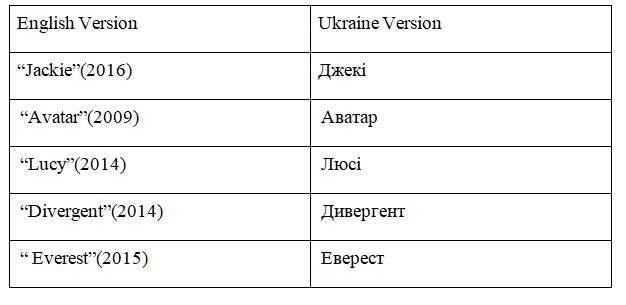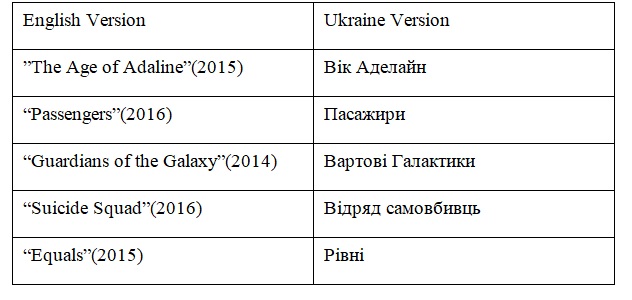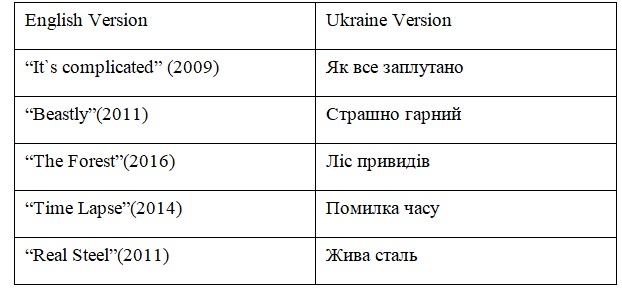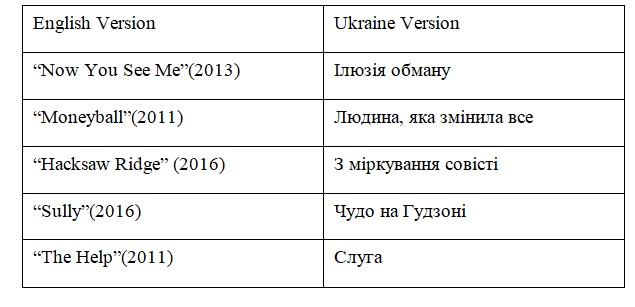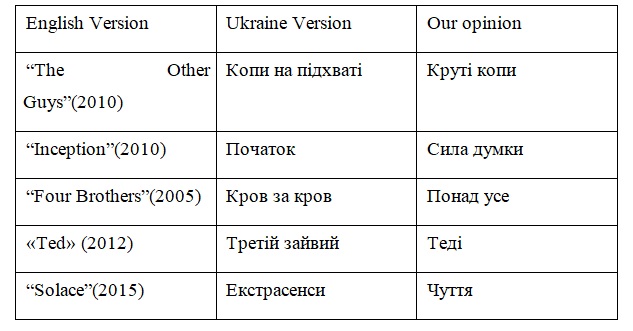Подзюбанчук І.М., Сокол Т.В. Film title translation: modern trend and tendencies (English and Ukrainian versions)
Матеріал з PSYH.KIEV.UA -- Вісник психології і соціальної педагогіки
Подзюбанчук І.М. – студентка Педагогічного інституту Київського університету імені Бориса Грінченка, напрям підготовки «Початкова освіта», кафедра іноземних мов і методик їх навчання Київського університету імені Бориса Грінченка
Сокол Т.В. – студентка Педагогічного інституту Київського університету імені Бориса Грінченка, напрям підготовки «Початкова освіта», кафедра іноземних мов і методик їх навчання Київського університету імені Бориса Грінченка
Анотація: У статті досліджується поняття перекладу назв фільмів, розглядається специфіка її формулювання на прикладі англійської та української мов. Автор аналізує сучасні тенденції перекладу назв фільмів, визначаючи різноманітні варіантти їх використання, на основі наукових досліджень та практичного досвіду різних країн. У статті описана класифікація типів перекладу назв фільмів та подано приклади найуживаніших мовних одиниць.
Ключові слова: фільм, назва фільму, переклад, українська версія перекладу, англійська версія перекладу.
Аннотация: В статье рассматривается понятие перевода названий, анализируется специфика его формулирования на примере английского языка. Авторы изучают современные тенденции перевода названий фильмов, преимущества и недостатки его использования, на основе научных исследований и практического опыта различных стран. В статье выделена классификация типов переводов фильмов и поданы примеры наиболее употребляемых языковых единиц.
Ключевые слова: фильм, название фильма, перевод, украинская версия перевода, английская версия перевода.
Annotation: This article examines the film title translation, specifics of its formulation in the English and Ukrainian language. finding out different ways of translation, studying scientists’ and linguists’ opinions about the issue. The authors highlight the main rules and tricks in using the film title translation.
Key words: film, title translation, translation trends, English version, Ukrainian version.
Зміст |
Problem setting
Nowadays we can`t imagine our lives without watching difference films and movies. There are a great number of film production studios which are popular throughout the world. So the majority of modern films are made in English. After that the best sellers are dubbed into different languages. That’s why film title translation is so significant.
Analysis of recent achievements and publications
Film title translation is examined by such scientists: Louis George Alexander, Mona Baker, John Platt and Heidi Platt, Jack C. Richards, Gideon Toury, Rojer T. Bell, Eugene Nida, Alexei Parshin, Inna Milevich.
The objective of the article
In recent years, modern Ukraine basic part of movies translated into Russian. But over the past 2 years we can see the trend is translated into Ukrainian. Important in translation is a right translation of the film title. The film title ought to be short, content, attractive, understandable to the audience. It is also important to translate the name sound naturally.
Analyzing educational literature and publications in the field of film title translation we try to highlight following top-priority goals: 1) analyze modern trends and tendencies of film title translation; 2) define the place of film title translation in the modern language; 3) find out advantages and disadvantages of film title translation.
The statement of the fundamental material
Modern scientist developed different film translation techniques. Techniques of English movie title translation mainly fall into two categories: showing respect for the original title (transliteration, literal translation, explication) and discarding the original one (free translation, nonequivalent). “No matter what technique is employed, one fundamental and vital principle that should never be forgotten is that the translation must be related to the story in one way or another.”[1]. In our opinion it is necessary to describe these techniques to show their difference:
Transliteration. As English movies often have their settings, heroes’ or heroines’ names as titles, transliteration, i.e. change only words. Transliteration tries to use a one-to-one correspondence so that an informed reader should be able to reconstruct the original spelling of unknown transliterated words. Transliteration can reserve the sounds of the original to the largest extent, keeping its rhythm and drawing the audience’s attention with strong exotic flavor. The main aspects of transliteration are names of people, places, especially, some exotic name, proper noun, historic events.
Literal translation. As most English movie titles consist of nouns or noun phrases, literal translation is the simplest and most effective technique used in movie title translation. Literal translation is widely used in English film titles’ translation. It remains the content and form of the original as much as possible. It attempts to recreate the precise meaning of the original within the limits of the target language’s grammatical structures and to be completely faithful to the intentions of the director. As for English film, literal translation is accessible, if target version corresponds to the original title, then the English film title could use literal translation.
Explication. To some titles, especially some allusive ones, whose literal translation cannot describe the story neatly and thus fails to provide information and attract the audience, more details have to be added to make them more explicit. Instead of being chosen randomly, these details should be based on the story and able to help polish the titles [2].
Free translation. The translator sometimes has to provide a new title for the movie and rely on his own intuition and taste to choose one good translation among all the possible translations. The new title should factually and accurately describe the story. Free translation is a strategy that seeks to convey the meaning and the spirit of the original title without sticking to the form mechanically; this method is frequently applied when literal translation is not suitable. Free translation reproduces the matter without keeping the manner, or keeping the content without taking the form of the original. Free translation version succeeds in exerting the functions of film titles and attracting the audience. It focuses on the target audience and serves the purposes of better communication.
The translator sometimes has to provide a new title for the movie and rely on his own intuition and taste to choose one good translation among all the possible translations. The new title should factually and accurately describe the story.
Non-equivalent translation. Sometimes the translator destroys the title of the film and so we get non-equivalent translation. It changes the title and the audience doesn't understand what they watch. You can confuse free translation and non-equivalent translation but the meaning are different. That`s why in our opinion, free translation is more appropriate variant and non-equivalent translation is not suitable one as it doesn't keep the main idea of the film and disorient the audience[3].
So, in the table below we have tried to give our own title translation the film with non-equivalent translation.
Conclusion and the prospects of the above research
We have analyzed modern trends and traditions in English films title translation and found out that it usually differs from the standard, and often has its own “rules”. The films play a great role in modern life, people can’t avoid its influence on the language. According to the research results every film title translation can exist as a headline, but not every of them is rather suitable and appropriate, so, it's important to use it in a proper way. Public sentiments about using film title translation are rather different, mostly according to their age. Film title translation depends on two categories. It is important to know that every film title translation must be easy to understand. So depending on the type, we have appropriate title translations. Nowadays we have film titles in English with one word so Ukrainian version has one word too. It is not difficult to translate film title into any foreign language.
In our opinion film title translations are very important in modern world, because we often watch the film and film title is the first that the audience can see and if this title is amazing than public want to see it.
References
- Nida E.A. Language and Culture: Contexts in Translation / E.A.Nida – Amsterdam and Philadelphia: John Benjamins Publishing Company, – 2001. – 125 pp.
- Gentzler E. Contemporary Translation Theories / E. Gentzler – Clevedon: Multilingual Matters, – 2001. –230 pp.
- Nida E.A. Toward a Science of Translating / E.A.Nida – Boston: Brill, – 2003. – 342 pp.
